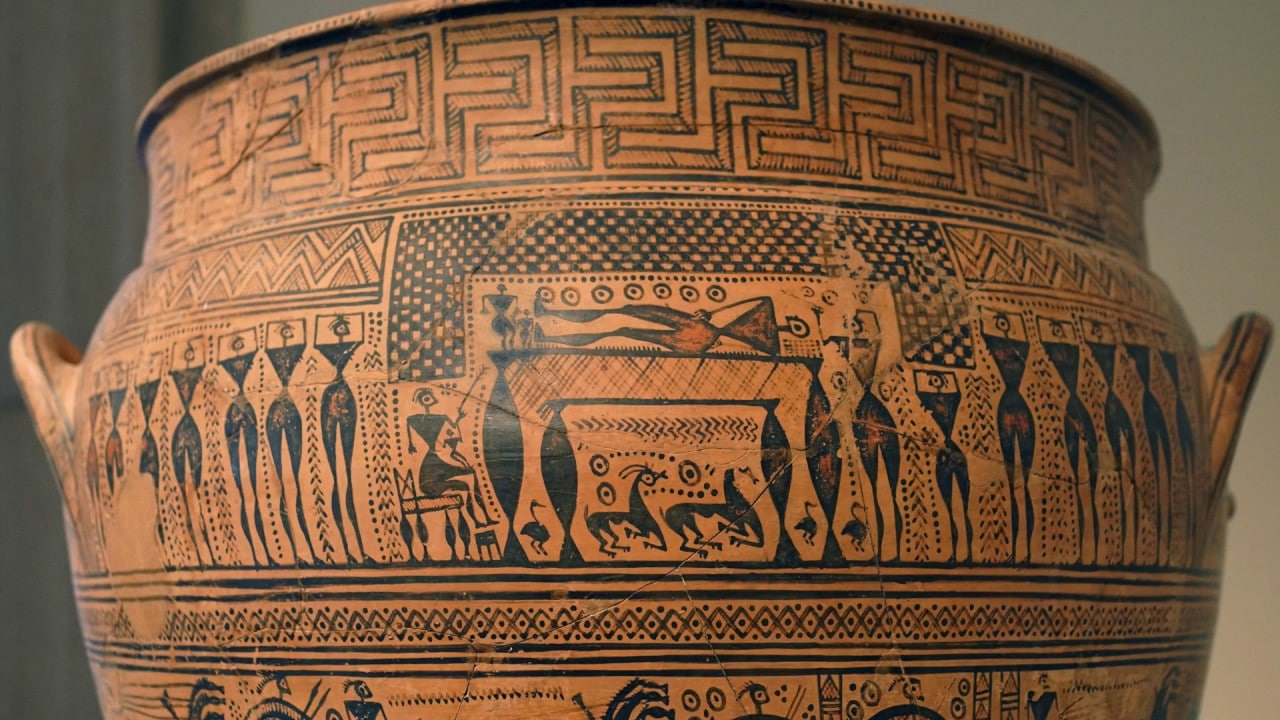Most ancient Greek pottery forms were made primarily for local use and are found almost exclusively near where they were produced. Local coarse wares, used primarily in the household, are ubiquitous. A few fine wares, such as Corinthian and Attic, were widely distributed in the Mediterranean at different times and are exceptions. The Etruscans, in particular, were fond of painted Attic pottery for their graves. The provenances of vases sent abroad provide valuable evidence for trade routes. Transport amphorae, the most important of the undecorated vases, are often found in shipwrecks and provide the most useful information.
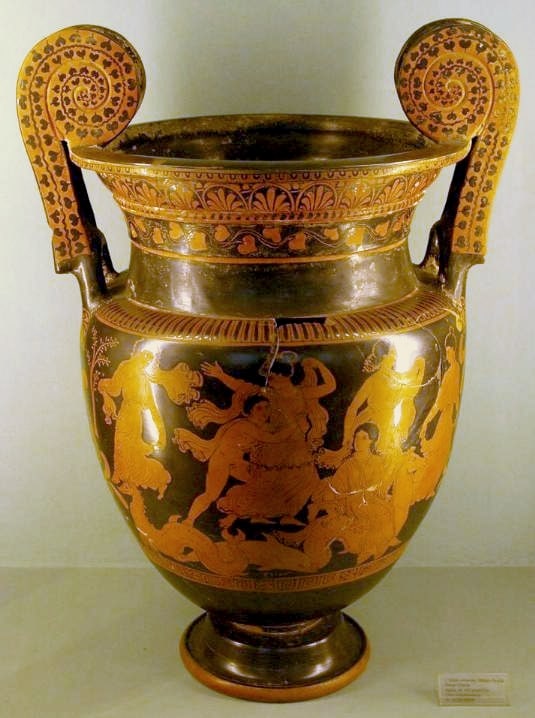 Practical, sharply defined, and well-proportioned shapes are another characteristic of Greek pottery. Although the details changed over time and varied in different areas, most of the same forms were used for centuries, and some are still with us today. The more important are large containers (amphorai, hydriai, and pelikai), small containers primarily for oil and perfume (alabastra, aryballoi, and lekythoi) or for small objects (lekanides and pyxides), drinking vessels (cups, kantharoi, and skyphoi), mixing vessels (dinoi, kraters, and stamnoi), jugs (oinochoai), storage vessels (pithoi), plates (pinakes), and ritual vessels (loutrophoroi and phialai). The potting is so distinctive and fine in some cases that individual potters have been identified. Some of the shapes, and perhaps many, are derived from metal prototypes, while a few are adaptations of foreign shapes or vessels made from other materials such as wood, stone, and leather.
Practical, sharply defined, and well-proportioned shapes are another characteristic of Greek pottery. Although the details changed over time and varied in different areas, most of the same forms were used for centuries, and some are still with us today. The more important are large containers (amphorai, hydriai, and pelikai), small containers primarily for oil and perfume (alabastra, aryballoi, and lekythoi) or for small objects (lekanides and pyxides), drinking vessels (cups, kantharoi, and skyphoi), mixing vessels (dinoi, kraters, and stamnoi), jugs (oinochoai), storage vessels (pithoi), plates (pinakes), and ritual vessels (loutrophoroi and phialai). The potting is so distinctive and fine in some cases that individual potters have been identified. Some of the shapes, and perhaps many, are derived from metal prototypes, while a few are adaptations of foreign shapes or vessels made from other materials such as wood, stone, and leather.
Stylistic Development
Figured decoration in a central band around the pot is a characteristic of most Greek fine wares. Stick figures, first animal and later human, appear in the eighth century B.C. during the latter half of the Geometric Period (ca. 900–700 B.C.), so-called after the neat and balanced rows of geometric patterns decorating parts of the vase. Although pottery in the Geometric style was produced in many regions of the mainland, islands, Italy, and the western coast of Turkey, the Athenians were the leaders in the development of figured scenes.
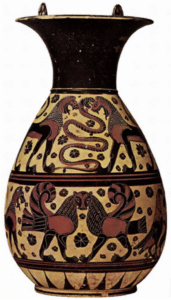 In the succeeding Orientalizing Period (ca. 700–600 B.C.), the stick figures flesh out, the geometric patterns disappear, and Orientalizing motifs, such as rosettes, pepper the background of the scenes that often include various Oriental beasts. A variety of drawing techniques are developed, including outline, polychrome, incision, and black figure, and mythological pictures start in earnest. Corinth is the leader, and Proto-Corinthian pottery (ca. 720–630 B.C.) with its lively animated scenes is the forerunner of full Corinthian (ca. 620–550 B.C.), which is characterized by the “animal style,” that is, stacked friezes with rows of animals—lions, panthers, goats, Sphinxes, and Sirens, among others. Corinthian vases were the most widely exported ware in the seventh century B.C., and they are found throughout the Mediterranean also during the first half of the Archaic Period (600–480 B.C.).
In the succeeding Orientalizing Period (ca. 700–600 B.C.), the stick figures flesh out, the geometric patterns disappear, and Orientalizing motifs, such as rosettes, pepper the background of the scenes that often include various Oriental beasts. A variety of drawing techniques are developed, including outline, polychrome, incision, and black figure, and mythological pictures start in earnest. Corinth is the leader, and Proto-Corinthian pottery (ca. 720–630 B.C.) with its lively animated scenes is the forerunner of full Corinthian (ca. 620–550 B.C.), which is characterized by the “animal style,” that is, stacked friezes with rows of animals—lions, panthers, goats, Sphinxes, and Sirens, among others. Corinthian vases were the most widely exported ware in the seventh century B.C., and they are found throughout the Mediterranean also during the first half of the Archaic Period (600–480 B.C.).
In the sixth century B.C., Attic black-figure pottery became the predominant fabric, replacing Corinthian by mid-century. It is characterized by figures painted black on the red-orange background of Attic clay with incision and added white and purplish red for details. Early on, the Corinthian animal style is often imitated, but later it and the Orientalizing fillers disappear, and mythological and everyday life scenes are the norm. Other regions developed their black-figure pottery, the most important being Laconian, Boeotian, and Chalcidian. The latter is now believed to have been made in southern Italy. There are also several important eastern Greek painted wares, such as Wild Goat and Fikellura.
Red-figure Technique
Around 530 B.C. the red-figure technique is invented in Athens. It is photonegative of the black-figure technique in that the figures are left in the red-orange color of the clay, having been outlined with a thick strip of black, and the background filled in with black. Relief lines help delineate many of the important features, and golden dilute gloss, the lesser features, and added white and purplish red are used, but to a lesser extent than on black-figure pottery. The more fluid, painterly lines produced with this technique quickly led to experimentation in foreshortening and depicting anatomy. By 480 B.C., Attic red-figure had replaced black-figure pottery as the predominate fine ware in the Mediterranean.
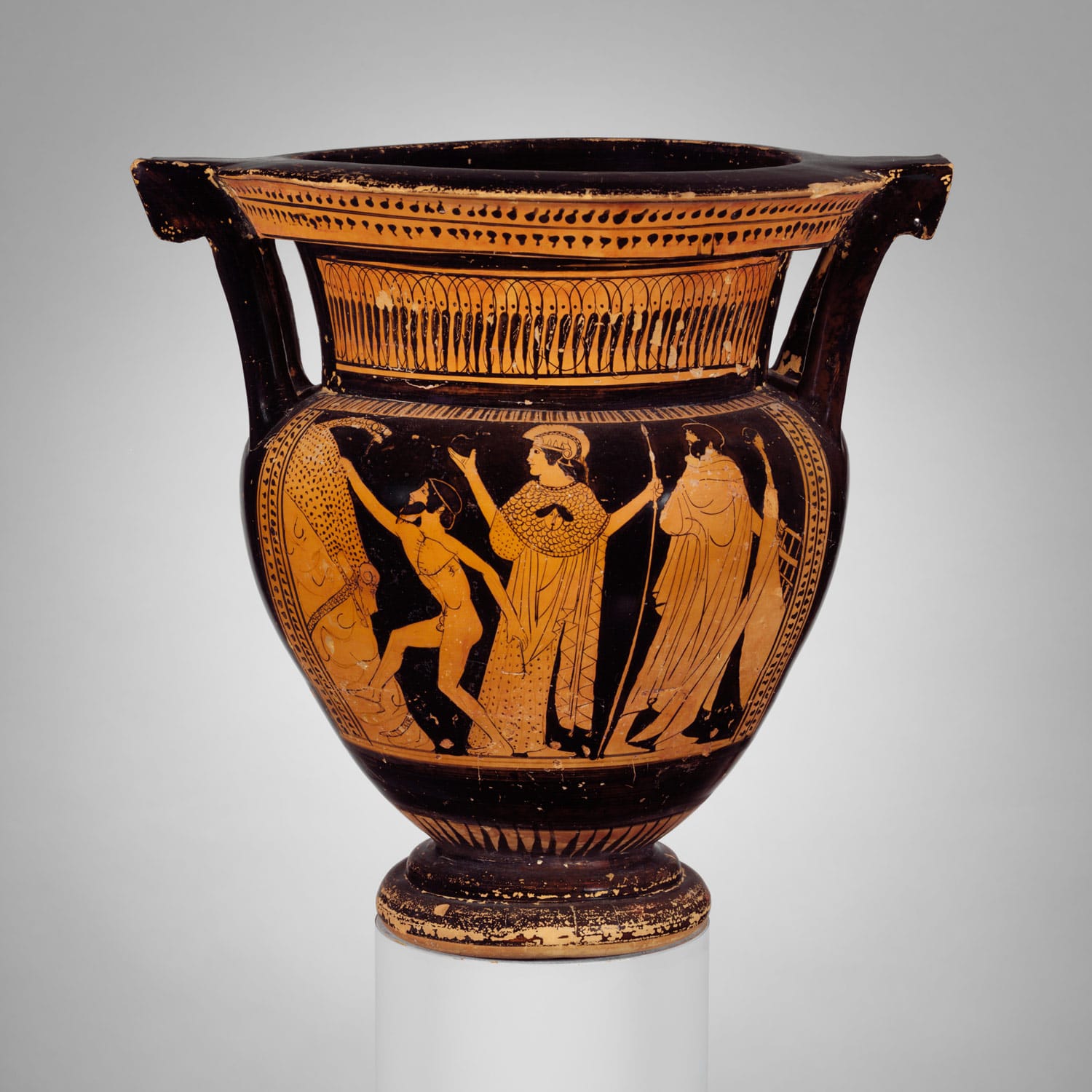 White-ground pottery is another important Athenian fifth-century-B.C. technique. The decorated area of the vase was first covered with a white slip, and then the figures and ornament were added over it in black gloss, dilutions thereof, and polychrome, the latter playing an ever increasingly important role. Lekythoi, intended primarily for local funerary use, is the dominant shape.
White-ground pottery is another important Athenian fifth-century-B.C. technique. The decorated area of the vase was first covered with a white slip, and then the figures and ornament were added over it in black gloss, dilutions thereof, and polychrome, the latter playing an ever increasingly important role. Lekythoi, intended primarily for local funerary use, is the dominant shape.
Later in the century, two southern Italian regions start producing their own red-figure pottery. Lucanian is the earliest, ca. 440 to 430 B.C., followed shortly by Apulian. At first, they are highly dependent on Attic models, but later develop their own traditions, including the tendency for more elaborate decoration with much greater use of color, floral ornamentation, and tiered compositions. Other important southern Italian red-figure pottery fabrics that developed in the fourth century B.C. are Sicilian, Campanian, and Paestan. The Italian fabrics replace Attic in Italy as the preferred, and a much larger portion of Attic is sent to the Black Sea and the eastern Mediterranean than previously. Several other areas develop their local red-figure pottery, including Boeotia and Corinth. The Etruscans also produced their red-figure pottery, as they had black-figure earlier. All of these were primarily for local use. Attic red-figure pottery loses its popularity at the end of the Classical Period (480–323 B.C.), and red-figure ware of all types virtually disappears by the end of the fourth century B.C.
Hellenistic Period
In the Hellenistic Period (ca. 323–31 B.C.), the tradition of painted figured decoration lingers on in a much-reduced form, primarily as occasional minor decoration on black wares. The two most important are West Slope ware on the mainland and in the east and Gnathian in the west. Figured scenes are found on some relief bowls, mold-made vessels produced in several locales, including Athens, Boeotia, the Peloponnese, Thessaly, Asia Minor, and Macedonia.
Fine ware painted black, sometimes banded or with stamped or incised decoration, was another important and widely exported fabric made in Athens between the sixth and fourth centuries B.C. Many areas made local imitations of it, and these took the place of Attic after ca. 400 B.C. With the cessation of red-figure pottery ca. 300 B.C., black gloss became the most important fine ware. Redwares replaced black gloss late in the Hellenistic Period, earlier in the east than in the west.
Study of Ancient Greek Pottery
Several of the artists decorating painted vases signed them, but most did not. Sir John D. Beazley (1885–1970) was the first to use the methodology of the art critic Giovanni Morelli (1816–1891), who believed that artists had standard formulae for many of the minor elements of their drawing by which they can be recognized. By comparing the details of drawing carefully, Beazley was able to isolate the many anonymous artists who decorated Attic black-figure, red-figure, and white-ground vases and to establish their stylistic relationships. Similar work has been done for other fabrics, most notably by Arthur Dale Trendall for southern Italian red-figure pottery. In this manner, the major artists and their characteristics and accomplishments have become known, and a firmer grasp on the development of Greek art has been gained.
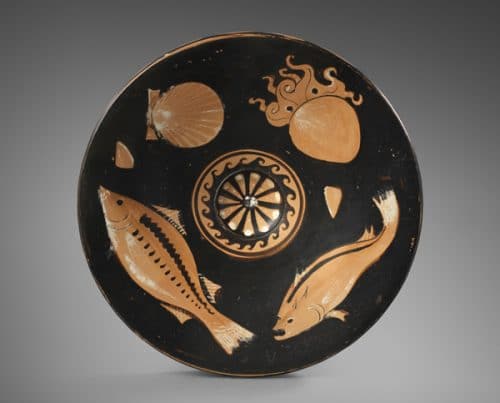 This stylistic sequence has been coordinated with securely dated monuments and the vases found in several finds with fixed historical dates so that most fine wares can be dated securely within a quarter of a century and some even within a decade. This makes them an extremely important dating tool for excavators.
This stylistic sequence has been coordinated with securely dated monuments and the vases found in several finds with fixed historical dates so that most fine wares can be dated securely within a quarter of a century and some even within a decade. This makes them an extremely important dating tool for excavators.
Subjects in Ancient Greek Pottery
The range of subjects depicted on Greek painted pottery is remarkable. Mythological scenes have received the most attention. Not only do they provide pictures of many of the stories from Greek and Roman literature, but in some cases, they provide myths or versions of myths, which are otherwise unknown. Sometimes they are our earliest source for a particular mythological character or story. The François vase in Florence, the most famous of all Greek vases, with its 270 figures, 130 inscriptions, and eight mythological friezes, is the best example and an important early source for myth.
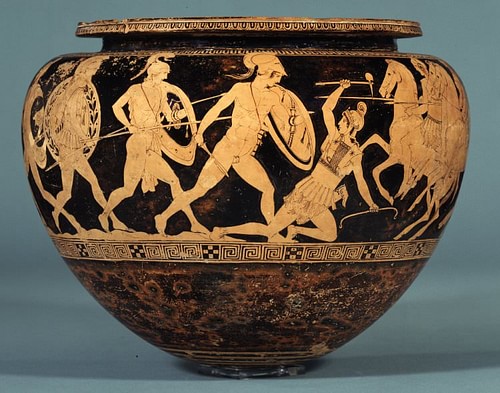 The study of the iconography of mythological scenes not only illuminates the changing nature over time of different stories and characters, but it also provides insights into various aspects of Greek life. Some vases are connected with the theater and provide information about lost plays. Other scenes and figures are thought to reflect political or historical events. For example, many scholars believe that the sudden popularity of scenes with Theseus in Athens at the end of the sixth century B.C. is connected with the founding of the new democracy. Still, other depictions appear to reflect lost monuments, such as the Niobid krater in the Louvre, which was almost certainly inspired by largescale mural wall paintings.
The study of the iconography of mythological scenes not only illuminates the changing nature over time of different stories and characters, but it also provides insights into various aspects of Greek life. Some vases are connected with the theater and provide information about lost plays. Other scenes and figures are thought to reflect political or historical events. For example, many scholars believe that the sudden popularity of scenes with Theseus in Athens at the end of the sixth century B.C. is connected with the founding of the new democracy. Still, other depictions appear to reflect lost monuments, such as the Niobid krater in the Louvre, which was almost certainly inspired by largescale mural wall paintings.
After the middle of the sixth century B.C., the range in scenes of everyday life expands. Just about every aspect of Greek life is depicted, making the vases an extremely important source. The activities include religious, military, seafaring, social (such as the wedding ceremony), athletic, industrial, domestic, musical, dance, and other entertainment. Some scholars have focused their attention on the subliminal meanings and attitudes reflected in both these and mythological scenes, giving us a better understanding of the Greek mentality.
Inscriptions
Many vases, but not a large proportion of the total, have inscriptions, a few of which are some of the earliest known examples of Greek writing. These are important documents for the history of the language and writing. The terms “egraphsen” and “epoiesen” occur most frequently on Attic pottery between 550 and 460 B.C., and although there is disagreement about the exact meaning in every case, “painter” for the first and “potter” or “workshop owner” for the second are the best and usual interpretations of the terms.
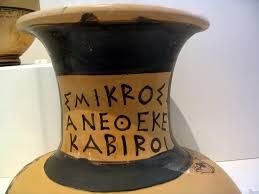 The evidence from these combined with that from studies of individual shapes and painters suggests that most pottery workshops were small, family affairs. Other types of inscriptions provide useful information about prosopography and chronology: these include kalos names praising the beauty of young Athenian aristocrats on Athenian pottery (primarily between ca. 550 and 450 B.C.), the archons and several other officials named on fourth-century Athenian Panathenaic prize amphorae, the manufacturers and officials listed on the stamps of transport amphorae, and the prominent citizens inscribed on ostraka, the pot shards used in Athens for voting in the process of ostracium.
The evidence from these combined with that from studies of individual shapes and painters suggests that most pottery workshops were small, family affairs. Other types of inscriptions provide useful information about prosopography and chronology: these include kalos names praising the beauty of young Athenian aristocrats on Athenian pottery (primarily between ca. 550 and 450 B.C.), the archons and several other officials named on fourth-century Athenian Panathenaic prize amphorae, the manufacturers and officials listed on the stamps of transport amphorae, and the prominent citizens inscribed on ostraka, the pot shards used in Athens for voting in the process of ostracium.
Some vases have trademarks that are painted or incised. Although they provide some information on prices and names of shapes, the meaning of many is unclear or far from certain concerning their role in the commercial process.
